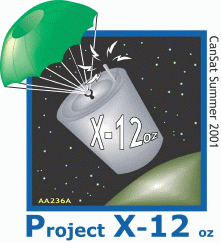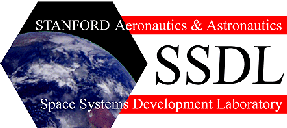| Home Page
Bus
Chute / Shell
Sensor
Power
Data Processing
Photos/Schematics
Results
Contact
|
|
 |
Hear ye, hear ye! The CanSat5 of X-12oz!
Welcome...
This website is the final product of our blood, sweat, and tears during our tenure as students in the first of the SSDL course series. The course, headed by Prof. Bob Twiggs, culminates in the design and construction of a science probe, the CanSat. The mission of the CanSat (this year our mission is named "x-12oz") is to collect as much data as possible on a make-belief target planetoid. This "planetoid" is actually a cow pasture at Stanford Hills by the radio dishes. For the Summer semester of 2001, 20 CanSat teams of two are participating. Each probe will carry payload that will collect various data samples on the planetoid. On August 17, 2001, an airplane carrying the CanSats flew over the cow pasture at an altitude of 2000 ft (above Sea Level), and launched the CanSats. |
Listing Site Updates
What's new with the CanSat5 website:
8/18/01 The website was created. Created Bus, Sensor, Parachute, Power, Data Processing, and Contact pages.
8/19/01 Added pictures of the CanSat 5 H/W. Uploaded CansSat cicuit drawings. Added additional liner notes. &Nbsp; Corrected own grammatical errors - there were numerous- and one spelling error.
8/20/01 Edited out and added liner notes. Added one more picture of H/W. Submitted the website to Prof Twiggs and search engines
8/21/01 Changed references to "fall" quarter to summer quarter.
8/27/01 Added a results page and uploaded Final Presentation Slides.
8/28/01 Added schematic of Voltage Controlled Oscillator with 555 timer on the data processing page. Added CanSat 5 logo. Cleaned up presentation slides' comments.
PLEASE "REFRESH" OR "RELOAD" TO VIEW UPDATED PAGES OF THIS SITE!
|
What in the world is a CanSat?
In a "canshell," it's essentially a gutted FRS radio hooked up to a microcontroller and sensors, all of it stuffed inside a soda/beer can attached to a parachute.
What's FRS? FRS stands for Family Radio Service, which refers to the radio frequency range allotted for amateur civilian use without licensing restrictions. Go here for more information on FRS.
What's a microcontroller? A microcontroller is a essentially a tiny computer on a Integrated Circuit chip. We used the BASIC Stamp II microcontroller from Parallax for the "brain" of our CanSat.
Each CanSat team uses some sensor for taking measurements of planetoid's property. Properties such as atmospheric temperature, density, and so forth.
What's the purpose? Why are we doing this?
Why not?
|
About Us and the Website
"Who are you?" you ask? We are two "rocket scientists" at Lockheed Martin Space Systems Company, Missiles & Space Operations of sunny Sunnyvale of California, and we thought it'd be cool to do some hands-on off-the-wall Hardware/Software project. First and foremost, we were drawn by the promise of designing and building ourselves a working vehicle within a college semester. We wanted to experience something beyond what we're paid to do at Lockheed. Goal of CanSat 5 Website We tried to make this website for the non-technically oriented. Send us your feedback. If you find any part of our website short on explanation, or if you discovered an annoying misspelled word, then let us have it, no holds barred. We will respond and make the necessary changes. Our intention is to inspire YOU to go off and do your own "design and build" project.
Disclaimer Note
First, we're not really rocket scientists. Second, Everything we've posted on this website should be treated with skepticism. We agreed that we needed to protect ourselves. So here goes: ALL of the information contained herein is purely for the entertainment of those who use the website. None of the information posted on the website is not guaranteed to be correct. Parties wishing to use the information on the website is free to do so at the user's expense. The webmasters will not be liable for damage, injury, or death caused by the use of this information. |


Click on logo to go to SSDL.
Send us email
|
|
|



